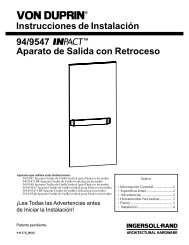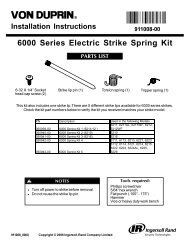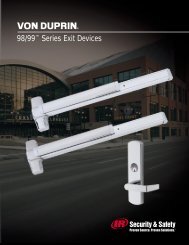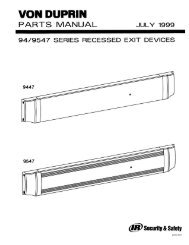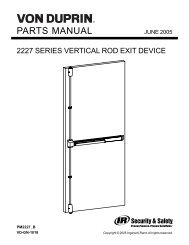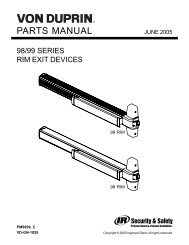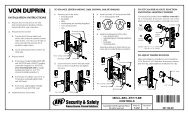Fire, Life Safety & Accessibility Codes - Von Duprin
Fire, Life Safety & Accessibility Codes - Von Duprin
Fire, Life Safety & Accessibility Codes - Von Duprin
You also want an ePaper? Increase the reach of your titles
YUMPU automatically turns print PDFs into web optimized ePapers that Google loves.
Highlights of the National Building Code of<br />
Canada 2005<br />
Door Release Hardware - Exits (3.4.6.15) - continued<br />
· device releases upon operation of a manually operated<br />
switch accessible only to authorized personnel, and<br />
· a force of 90 N applied to the door opening hardware<br />
initiates an irreversible process that releases the locking<br />
device within 15 seconds and device shall not relock<br />
until the door has been opened, and<br />
· upon release, the locking device must be manually reset<br />
by the switch referred to above, and<br />
· if more than one locking device of this type is used in a<br />
building, the switch must release and reset all locking<br />
devices simultaneously (appendix), and<br />
· a legible sign must be permanently mounted on the exit<br />
door to indicate that the locking device will release<br />
15 seconds after the application of force to the door<br />
opening hardware<br />
· operating hardware for the doors to in this section shall be<br />
installed 1200 mm maximum above the finished floor<br />
Security for Banks and Mercantile Floor Areas (3.4.6.16)<br />
· requirements of section 3.4.6.15 may be waived for bank and<br />
mercantile occupancies due to security concerns<br />
· buildings must be sprinklered throughout<br />
· consult section 3.4.6.16 for specific requirements<br />
Emergency Access to Floor Areas (3.4.6.17)<br />
In a building more than 6 stories high,<br />
· doors providing access to floor areas from exit stairs shall not<br />
have locking devices to prevent access to the floor area from<br />
which the travel distance up or down to an unlocked door is<br />
more than 2 stories<br />
· doors that provide access to the floor area (as required above)<br />
shall have signage on the stair side to indicate that they are<br />
openable from the stair side<br />
· a master key for all locked doors in a stairwell shall be provided<br />
in a designated location accessible to fire-fighters, or the locked<br />
door shall have a wire glass panel not less than 0.0645 m2 in<br />
area and located not more than 300mm from the door opening<br />
hardware<br />
· if access to floor areas through unlocked doors is required by<br />
this section, an occupant entering the floor area must have<br />
access, through unlocked doors within the floor area,<br />
to at least one other exit<br />
877.840.3621 • www.securitytechnologies.ingersollrand.com<br />
Barrier-Free Doorways and Doors (3.8.3.3)<br />
· every doorway in a barrier-free path of travel shall have a clear<br />
width of at least 800 mm when the door is in the open position<br />
(measured from the face of the door at 90 degrees to the outside<br />
edge of the frame stop, the projection of exit devices are taken<br />
into account - appendix)<br />
· the doorway of at least one bathroom within a residential suite<br />
must have a clear width of at least 800mm when the door is in<br />
the open position<br />
· door operating devices shall not require tight grasping or<br />
twisting of the wrist to operate<br />
· thresholds shall be a maximum of 13 mm above the floor surface<br />
and shall be beveled<br />
· doors that provide a barrier-free path of travel at an entrance<br />
referred to in Article 3.8.1.2 shall be equipped with a power<br />
operator in a hotel, a building of Group B, Division 2 major<br />
occupancy, and a building of Group A, D, or E major occupancy<br />
more than 500 m2 in building area (exception - individual suite<br />
having an area less than 500 m2 in a building having only suites<br />
of Assembly Occupancy, Business and Personal Services<br />
Occupancy, or Mercantile Occupancy if the suite is completely<br />
separated from the remainder of the building so that there is no<br />
access to the remainder of the building<br />
· door closers used in a barrier-free path of travel shall require<br />
a maximum force applied at the handle, push plate, or latch<br />
releasing device of no more than 38 N to operate an exterior<br />
door and 22 N to operate an interior door (exception - entrance<br />
to a dwelling unit, or where greater forces are required to close<br />
the door against prevailing difference in air pressure)<br />
· door closers used on interior doors in a barrier-free path of<br />
travel shall have a closing period of not less than 3 seconds from<br />
the open position of 70 degrees to a point 75mm from the closed<br />
position, measured from the leading edge of the latch side of the<br />
door (exception - dwelling unit entrance doors), delayed action<br />
not required (appendix)<br />
· only the active leaf in a multiple leaf door in a barrier free path<br />
of travel need to conform to the requirements<br />
21



